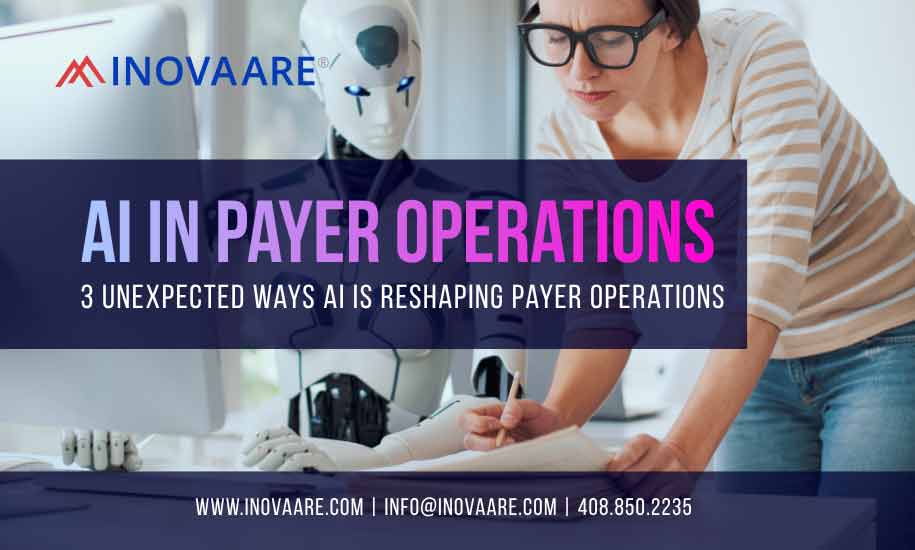It’s hard to ignore the constant headlines about Artificial Intelligence in healthcare. The integration of AI in payer operations is becoming particularly significant in this field. The conversation is often dominated by a sense of unease, marked by regulatory discussions from bodies like CMS and pushback from provider groups such as the American Hospital Association.
This tension between AI’s potential and its perceived risks can obscure what’s actually happening on the ground.
While the industry debates the future, leading payers are already moving past pilots and proofs of concept to embed AI at scale, not as a shiny add-on, but as a strategic lever driving better outcomes, smarter operations, and more connected member experiences.
This piece looks beyond the hype to explore how AI is quietly, yet profoundly, transforming payer operations.
Understanding the evolution of AI in payer operations
Before diving into where AI is making the biggest impact, it’s important to clarify what’s actually driving this change. The conversation has shifted from AI to AI agents, and the distinction matters.
What makes AI agents different
Unlike traditional AI or even Generative AI models that focus on isolated tasks like prediction, content generation, or data analysis, AI agents are designed to “act”. They combine reasoning, automation, and learning to perform complex, multi-step tasks autonomously, within defined enterprise guardrails.
In payer operations, that means an AI agent can interpret a new CMS memo, identify which policies it affects, trigger the corresponding compliance updates, and even summarize the impact for reporting, without waiting for manual input.
AI agents mark a turning point from assistance to autonomous action. They operate with context, memory, and purpose, adapting to business logic while maintaining compliance and auditability, enabling payers to not just use AI, but to run on it.
AI agents are not a distant concept; they’re already at work across payer ecosystems, quietly transforming the way health plans operate, serve members, and manage compliance. Their impact is showing up in unexpected but deeply strategic ways that go far beyond automation or efficiency gains.
Here are three such shifts that reveal how AI is redefining payer operations today.
1. It’s not just about efficiency, it’s about proactive member safety
When most people think of AI in insurance, they picture automated call centers or streamlined claims processing. But its real impact is emerging in areas that directly affect lives.
Take EmblemHealth’s weather-resilience program. In New York City, nearly 500 people die each year due to extreme heat. EmblemHealth uses AI voice agents to identify at-risk members and reach out with critical resources before heat-related emergencies occur.
This reframes AI’s role from a reactive, cost-saving tool to a proactive, life-saving one. By anticipating risks and enabling early interventions, AI directly supports member safety and lowers preventable healthcare costs. It’s a powerful business imperative aimed at reducing high-acuity, high-cost emergency events before they happen. It’s a model payers can replicate for other public health risks like wildfire smoke or flooding, a blueprint for climate-informed, member-first healthcare.
2. It’s a bridge for members and providers, not just a tool for one
Next-generation AI agents are dissolving the long-standing wall between member engagement and provider coordination.
Instead of automating a single, isolated task for one audience, this model positions AI as an integrated communication partner for everyone involved in a member’s care journey.
Oscar Health’s AI agent, Oswell, does exactly that. It is designed with two distinct but connected functions:
- Member-facing: Oswell helps members understand complex information, empowering them to unpack test results, get clarity on prescriptions, and make sense of their symptoms.
- Provider-facing: Simultaneously, the agent supplies providers with valuable patient data insights, giving them a more complete picture of their patients’ health status and needs.
This dual-design positions AI as a shared intelligence layer, not a siloed tool. It closes the information gap that drives miscommunication, member frustration, and inefficiency, transforming AI from a digital assistant into a collaboration enabler that empowers both sides of the care equation.
3. The scale of adoption has outgrown pilot programs
AI has matured from a departmental experiment to a full-scale enterprise capability.
UnitedHealth Group currently has over 1,000 distinct AI use cases in production, ranging from transcription tools to claims processing support. This figure signifies that AI is no longer a siloed IT project but a foundational, horizontal capability integrated across the entire enterprise.
This trend extends beyond a single carrier, as other major players like SCAN Health Plan and Elevance Health are also harnessing AI in their call centers.
This marks a shift from tactical automation to strategic transformation. AI is now foundational to payer operations, enabling faster decision-making, higher member satisfaction, and measurable cost and compliance improvements.
From tactical tool to strategic partner
EmblemHealth, Oscar, and UnitedHealth show what AI maturity looks like: proactive risk mitigation, seamless communication, and enterprise-wide adoption. Together, these examples reveal how payers can move from “using AI” to “running on AI”, with the technology acting as a strategic partner for mission delivery.
The question is no longer if payers should adopt AI. It’s how they can do it responsibly, at scale, and with measurable ROI.
The Inovaare perspective: Turning AI promise into operational performance
Inovaare helps payers move beyond pilots to compliant AI adoption at-scale. Our Healthcare Industry Cloud Platform, powered by Usher AI and AI Agents, combines governance, automation, and intelligence across payer operations, from Appeals & Grievances and Delegation Oversight to Audit, Reporting, and Regulatory Compliance.
Our solutions ensure:
- AI with guardrails: HIPAA-compliant, HITRUST-certified, CMS-aligned, and human-in-the-loop by design
- AI with context: Embedded in workflows across departments, not siloed tools.
- AI with ROI: Proven gains in audit readiness, efficiency, and member satisfaction.
Health plans don’t just need technology. They need technology that understands healthcare.
Learn how Inovaare can help you deploy compliant and effective AI solutions.
Visit Inovaare’s AI & AI Agents | Talk to our strategy team | Download the AI-Powered Digital Transformation Playbook
